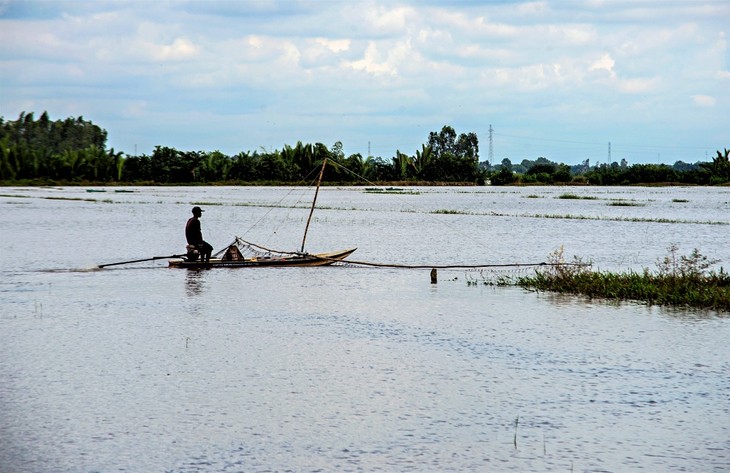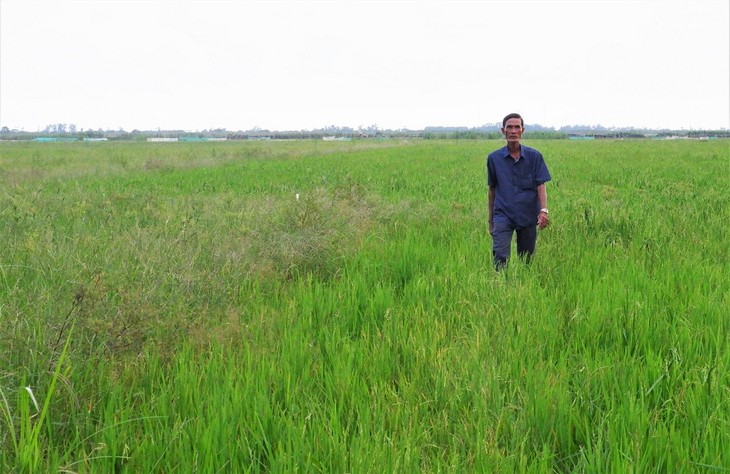(VOVWORLD) - According to the Southern Hydrometeorology Station, the water level at the riverhead of the Tien River in An Giang province is 2.7 meters and 2.56 meters on the Hau River. The levels are this year’s flooding peak forecast but will likely be lower than the average level in previous years, even lower than the record low set in 2019. Farmers in An Giang are waiting for floodwaters to allow them to earn a living.
|
 The paddy fields are less flooded and offer less fish and other aquatic species. The paddy fields are less flooded and offer less fish and other aquatic species.
(Photo: VOV)
|
It is November now but the water level is very low in rivers and canals in upstream areas of the Mekong. The water barely reaches the roots of the rice plants.
80-year-old Nguyen Van Sam of Vinh Hoi commune in An Phu, an upstream district of An Giang province, said his family doesn’t have rice fields and lives on fishing all year round. Every year, aquatic resources brought by the flood season are the main source of income for his family and their neighboors.
Sam said the flood season will likely come late this year, making their livelihood more difficult.
Sam told VOV, “I’m 80 years old now, and this is the first time I’ve seen such a shortage of floodwater. Without floodwater, we will surely be in distress. Previously we could earn up to 2,600 USD every flood season.”
Nguyen Van Gang of Phu Hoi commune in An Phu district, who buys from local fishermen said that in previous years he was collecting tons of fish and shrimp every day, but this year is only about 20% of last year.
“A majority of local people do farming and trade services in addition to what they catch during the flood season. A number of people have bought 1,300 USD worth of fishing gear, which is going unused. It’s a difficult period because of the drought, and the COVID-19 epidemic is hindering us from trading in Cambodia,” said Gang.
Pham Thanh Tam, Deputy Head of the Agriculture and Rural Development Section of An Phu district, said that 70% of local people who used to catch fish and other aquatic species in the flood season have found other jobs or gone to work far from home.
He said that pursuant to this year’s agricultural production plan, An Phu will discharge water into the fields over an area of 1,500 ha. But if the water level is too low, the next winter-spring rice crop will be affected.
According to Tam, “The locals have not planted a crop in areas without dikes because they don’t know when floodwater will come. If there are no floods, the fields will lack silt, and wild grass will not be washed away, and farmers will have to spend more on pesticide and fertilizers. And without floodwater, there won’t be aquatic resources.”
|
 Wild grass and the roots of rice plants of the previous crop have popped up in rice fields. Wild grass and the roots of rice plants of the previous crop have popped up in rice fields.
(Photo: VOV)
|
The Southern Hydrometeorology Station reports that this year’s floods will come later than average, and total rainfall in the upstream areas and throughout the region will be 25% less than average. The flow into the Mekong Delta since the beginning of the flood season is the lowest in history - 31 to 49% lower than the average. This year's peak floodwater level is forecast to be 0.2 to 1.6 meters lower than the average.
Ky Quang Vinh, former director of the Can Tho Center for Natural Resources and Environmental Monitoring and an expert on the Mekong Delta’s ecology, said that if upstream Mekong countries don’t have frequent, heavy rains from now until the end of the rainy season and have a normal dry season next year, it will be a disaster for the Delta’s agricultural production.
“The floods usually start coming in late July in the Mekong Delta. It’s forecast that there may not be a flood season in the Delta this year because of climate change. Meanwhile next year may see a severe drought. So we need to pay close attention from now on and take appropriate measures,” Vinh explained.
After last year's drought, people in the upstream Mekong Delta provinces are waiting for big floods to remove acidity and alum, deposit silt for rice fields and provide aquatic resources. But the water level in rivers and canals in the upstream areas remains low, suggesting a drought may come sooner and more severe than last year.